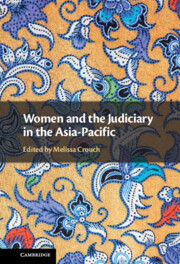Book contents
- Women and the Judiciary in the Asia-Pacific
- Women and the Judiciary in the Asia-Pacific
- Copyright page
- Contents
- Figures
- Tables
- Preface
- Contributors
- Abbreviations
- 1 The Feminisation of the Judiciary in the Asia-Pacific
- 2 ‘To Join the Bench and Be Decision-Makers’
- 3 Reframing Feminist Imperatives in Adjudication through a Reading of Sri Lankan Jurisprudence
- 4 Women in the Thai Judiciary
- 5 The Promise and Paradox of Women Judges in the Judiciary in Indonesia
- 6 Filipino Women Judges and Their Role in Advancing Judicial Independence in the Philippines
- 7 One Decade of Female Judges in the Malaysian Shariah Judiciary
- 8 Gender on the Bench Matters for Sustainable Development
- 9 Feminising the Indian Judiciary
- 10 Concluding Remarks
- Index
- References
9 - Feminising the Indian Judiciary
The Gender Gap and the Possibilities of Objectivity
Published online by Cambridge University Press: 21 October 2021
- Women and the Judiciary in the Asia-Pacific
- Women and the Judiciary in the Asia-Pacific
- Copyright page
- Contents
- Figures
- Tables
- Preface
- Contributors
- Abbreviations
- 1 The Feminisation of the Judiciary in the Asia-Pacific
- 2 ‘To Join the Bench and Be Decision-Makers’
- 3 Reframing Feminist Imperatives in Adjudication through a Reading of Sri Lankan Jurisprudence
- 4 Women in the Thai Judiciary
- 5 The Promise and Paradox of Women Judges in the Judiciary in Indonesia
- 6 Filipino Women Judges and Their Role in Advancing Judicial Independence in the Philippines
- 7 One Decade of Female Judges in the Malaysian Shariah Judiciary
- 8 Gender on the Bench Matters for Sustainable Development
- 9 Feminising the Indian Judiciary
- 10 Concluding Remarks
- Index
- References
Summary
This chapter looks at the nuances of gender dynamics in the Indian judiciary since independence. The Supreme Court has only eight female judges, or 11 per cent and there has never been a female chief justice of India. The gender gap in the judiciary is therefore complex and its possible impact on the discourse of legal tradition in India. The immobility of women in the highest court of law compels us to relook at hierarchy, representation and the institutional processes involved in the judiciary. The chapter will also look at the idea of gendered objectivity and its interconnectedness with the process of maneuvering gender discourse within the system. The chapter will look at the historical representation of women in the judicial system, followed by a consideration of what gender ‘objectivity’ denotes in the course of judgments. With recent path-breaking judgments pertaining to gender discrimination and equal rights, the third section will highlight the overall impact of women’s representation in the judiciary and the possibilities for change in addressing issues of women.
- Type
- Chapter
- Information
- Women and the Judiciary in the Asia-Pacific , pp. 261 - 290Publisher: Cambridge University PressPrint publication year: 2021



